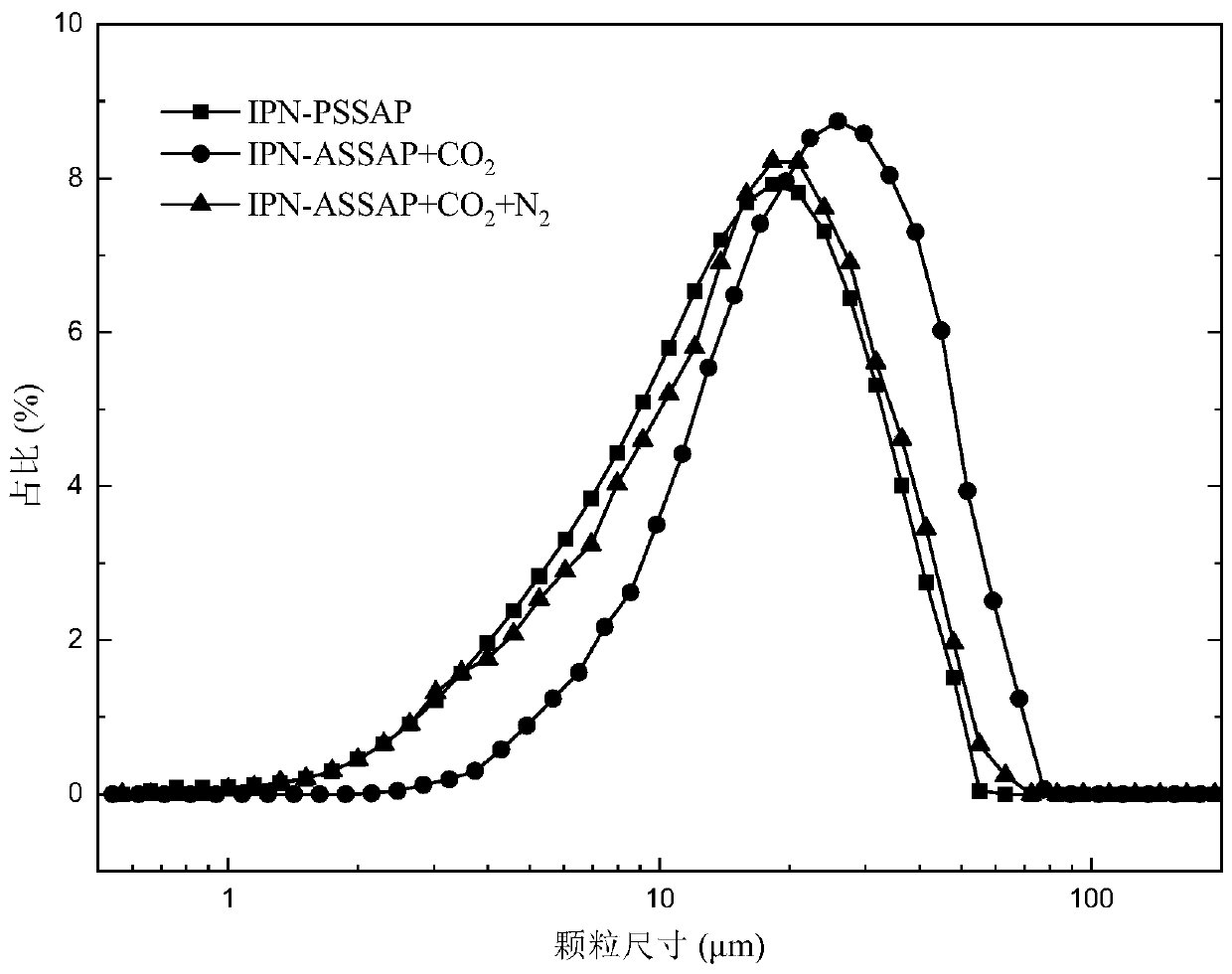Responsive interpenetrating network gel particles for preventing CO2 gas channeling of compact oil reservoirs and preparation method thereof
A technology of gel particles and interpenetrating networks, which is applied in the direction of chemical instruments and methods, drilling compositions, etc., can solve the problems of matrix start-up difficulties, excessive permeability differences, etc., and achieve good response reversibility and increased regulation Intensity, the effect of increasing intensity
- Summary
- Abstract
- Description
- Claims
- Application Information
AI Technical Summary
Problems solved by technology
Method used
Image
Examples
Embodiment 1
[0036] (1) Dissolve 48g of acrylamide, 6g of methacryloyl chloride-modified alkylphenol polyoxyethylene ether and 0.2g of N,N-methylenebisacrylamide into 150mL of distilled water using ultrasound;
[0037] (2) Slowly add 0.01 g of ammonium persulfate into the system, blow N2 for 30 minutes to remove oxygen in the system, raise the temperature to 50°C, and react for 4 hours to obtain a pre-crosslinked gel.
[0038] (3) The obtained gel is granulated, dried at 70° C., and then pulverized to obtain pre-crosslinked gel particles (ASSAP).
[0039] (4) Add the pre-cross-linked gel particles obtained in step (3) to the solution of 10g dimethylaminoethyl methacrylate, 0.03g 4,4'-azobis(4-cyanopentyl) under stirring condition acid) and 0.2g of N,N-methylenebisacrylamide in 100ml of deionized aqueous solution, let the mixture absorb water to swell for 24 hours, then raise the temperature to 70°C again, and react for 4 hours to obtain it.
[0040] (5) The obtained gel is granulated, dri...
Embodiment 2
[0044] Preparation of CO 2 The method of the responsive interpenetrating network gel particle is the same as that of Example 1, the only change is that in step (2), 0.1 g of ammonium persulfate is changed to 0.08 g of azobisisobutylamidine hydrochloride.
Embodiment 3
[0046]Preparation of CO 2 The method of the responsive interpenetrating network gel particle is the same as that in Example 1, the only change is that in step (4), dimethylaminoethyl methacrylate is replaced with dimethylaminopropyl methacrylamide.
[0047] (2) Performance test:
[0048] 1. CO 2 Responsive performance testing
[0049] In order to test the CO of the present invention 2 Responsive interpenetrating network gel particles for CO 2 Responsiveness, take the CO in Example 1 2 Responsive interpenetrating network gel particles, using a laser particle size analyzer to measure CO influx into gel particles 2 The size distribution before and after is measured, and the specific test results are as follows figure 1 shown.
[0050] from figure 1 It can be seen that the CO 2 Before, the size distribution of the gel particles was 0.6 μm to 55 μm, and the median particle size was 18.24 μm; CO was introduced at a rate of 10ml / min 2 After 30 minutes, the size distribution...
PUM
| Property | Measurement | Unit |
|---|---|---|
| size | aaaaa | aaaaa |
| particle size | aaaaa | aaaaa |
| size distribution | aaaaa | aaaaa |
Abstract
Description
Claims
Application Information
 Login to View More
Login to View More - R&D
- Intellectual Property
- Life Sciences
- Materials
- Tech Scout
- Unparalleled Data Quality
- Higher Quality Content
- 60% Fewer Hallucinations
Browse by: Latest US Patents, China's latest patents, Technical Efficacy Thesaurus, Application Domain, Technology Topic, Popular Technical Reports.
© 2025 PatSnap. All rights reserved.Legal|Privacy policy|Modern Slavery Act Transparency Statement|Sitemap|About US| Contact US: help@patsnap.com



